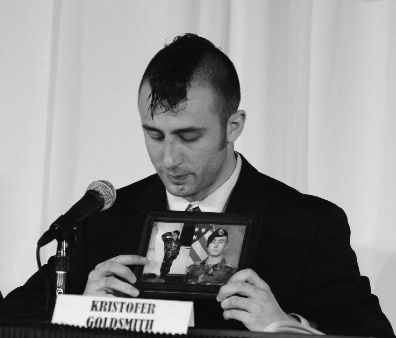

Through their occupation of Iraq, the Bush administration and Congress are running our military into the ground. Afraid to implement a draft like the one during the Vietnam War, politicians have sent the same soldiers to the front again and again. More than 565,000 Americans have been deployed more than once to Iraq or Afghanistan.1 In December 2006 the organization Swords to Plowshares reported approximately 50 percent of troops in Iraq were enduring their second tour of duty. Another 25 percent were on their third or even fourth tour.2
The Pentagon is so stretched that more than forty-three thousand troops listed as medically unfit for combat have been sent anyway.3 Many of these troops are being redeployed despite surviving a traumatic brain injury, physical brain damage, which is often caused by roadside bombs. Others are being sent to the front despite being diagnosed with Post-Traumatic Stress Disorder, or other severe mental health conditions are being “layered” with PTSD as the horrors of one deployment get caked onto another.
In November 2006 the Pentagon released guidelines that allow commanders to redeploy soldiers with “a psychiatric disorder in remission, or whose residual symptoms do not impair duty performance.” The guidelines list PTSD as a “treatable” problem and set out a long list of conditions when a soldier can and cannot be returned for an additional tour in Iraq. Those on lithium, for example, would not be allowed to deploy, while those on another class of medications similar to Prozac may be sent to the front.4 As of October 2007, the army reports about 12 percent of combat troops in Iraq and 17 percent of those in Afghanistan were taking prescription antidepressants or sleeping pills to help them cope.5
This is not only troubling given the stress on the individual servicemember, it’s also dangerous for the civilians and other soldiers around him or her. “As a layman and a former soldier, I think that’s ridiculous,” said Steve Robinson, a Gulf War veteran who works for the organization Veterans for America. “If I’ve got a soldier who’s on Ambien to go to sleep and Seroquel and Klonopin and all kinds of other psychotropic meds, I don’t want them to have a weapon in their hand and to be part of my team because they’re a risk to themselves and to others.”
The army admits the policy is unconventional but maintains it is necessary given the difficultly it’s having mustering enough soldiers to continue the occupations of Iraq and Afghanistan. “Historically, we have not wanted to send soldiers or anybody with post-traumatic stress disorder back into what traumatized them,’’ Colonel Elizabeth Ritchie told the Hartford Courant. “The challenge for us…is that the Army has a mission to fight.’’6
The length of this war has also caused the Pentagon to continue a policy called “stop-loss,” whereupon soldiers are redeployed to Iraq or Afghanistan even after their contract with the military is over. Since September 11, 2001, more than fifty-eight thousand troops have been “stop-lossed,” which critics label a back-door draft.7
Making matters worse is the fact that many of the soldiers sent to occupy Iraq never imagined they would be sent abroad. Over 250,000 National Guardsmen have been forced to fight overseas in the War on Terror.8 These men and women who signed up provide emergency help during a flood, earthquake, or civil disturbance are now no longer eligible to do that job, leaving the domestic security of our country at risk.
Military equipment is also breaking down. In March 2007, then-head of the Joint Chiefs of Staff General Peter Pace told a House of Representatives Committee that 40 percent of army and Marine Corps equipment is deployed in Iraq and Afghanistan or being repaired in depots. “It will take end of war plus two years to work off the backlog,” Pace told the House Appropriations Defense Subcommittee. “Without being able to give you a [date for the] definite end of war, I can’t tell you exactly how long.”9
All this adds up to a military that is burned out. In the testimony that follows you’ll see how that plays out for the soldiers on the ground. American soldiers patrol the streets of Iraq in unarmored Humvees and broken-down Bradley fighting vehicles. When they return, they can’t find a military doctor to treat their head injury and then are ordered to deploy for a second, third, or fourth tour. Some see suicide as the only way out.